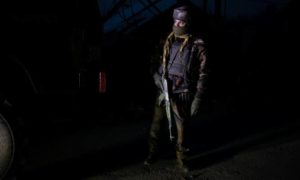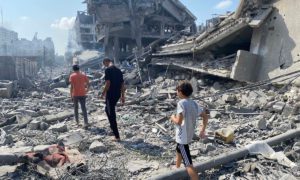A chilling reminder of how turmoil is escalating in Kashmir lately came from Kulgam where civilians were consumed as cannon-fodder by a blast. The fresh death count including the three armed and the seven unarmed Kashmiris underlines the growing travesty of life in the world’s oldest unresolved conflict zone.
Srinagar’s twin hospitals—SMHS and SKIMS—once again became war-theatres after the wounded from Kulgam were rushed there in an overwhelming situation on October 21. A few returned quickly, with a body bag of their beloveds; while many are still around, attending to their loved ones miraculously spared by the earth-shaking blast in their backyard which became a latest flashpoint in Kashmir.
For a while, says an anxious relative of an injured person admitted in SKIMS, it felt as if the bomb was set off to derail the villagers running towards the gutted gunfight site.
“It was so sudden that we thought we’ve been bombed—until some of us found our brethren lying dead around the debris of the gunfight site,” says Gowher, attending to his cousin in the hospital gripped with sorrow and solidarity.
Even before the wounded would be transported to Srinagar for emergency treatment, the southern Kashmir’s restive zone which post-2016 witnessed the fiercest clashes and surge in insurgency was in the middle of another deadly day.

The gunfight site in Kulgam.
It began when a joint team of Indian Army’s 9RR, CRPF and SOG cordoned off Larro area of Kulgam after receiving information about the presence of militants there. In an ensuing gunfight, bodies of three local Jaish-e-Mohammad militants—Zubair Lone of Awhatoo Kulgam, Shahdil Tantray of Wangam Shopian and Yazil Makro of Arwani Islamabad—were retrieved from the rubble.
Although such killings have now become a disturbing routine in Kashmir, what unfolded in Kulgam, however, shocked everyone.
Locals say the counter-insurgents had left the smoking site without sanitization, despite the fact that for years civilian population in Kashmir have been running towards the gunfight sites—notwithstanding advisories and warnings—in a bid to rescue their armed counterparts.
When the villagers at Laroo did the same on Sunday morning, a blast went off and threw many of them lifeless and bleeding.
Along with the update, the news about civilian deaths in Kulgam started pouring in. Heart-wrenching videos and photos showing men carrying brutally injured locals, women beating their chests; blood, pen and pencil on streets and stretchers; mother lying on side of her dead son hysterically smiling, crying and kissing him, started filling feed on social networking sites.

Photo: Firdaus Qadri.
“We rushed to the encounter site while it was still going on. The forces fired pellets and my friend got hurt. Then, we left at 10.30 am. But, it was followed by the dance of death,” says Nisar, an attendant at SMHS Hospital. “We don’t know what happened after that. My friend was hospitalised. And right now you cannot get in touch with anyone from Kulgam as the network has been blocked there.”
The tragedy, Nisar says in an SMHS corridor filled with the relatives of the injured persons, struck near the veranda of the house in which militants were hiding. Police, however, say it took place on the rear side of the house when “locals were digging, searching for weapons of militants”.
By then, however, the gory images of the carnage—especially that of a blood-flooded stretcher carrying the fallen civilian—had shaken the valley.

Photo: Saqib Makhdoomi.
“When the forces left after the encounter,” Kashmir police chief, IGP SP Pani said in Srinagar, “there was a congregation which came close to the house and were trying to fiddle with the remnants of explosives. It blasted and six civilians (now 7) died. We request citizens to not venture into houses which are not cleared by the security forces.”
Even Kulgam police chief Harmeet Singh Mehta would later exhort people to stay away from the smouldering gunfight sites till sanitization. By then, however, the district had lost the dear.
The macabre scenes sent another day in Kashmir into mass mourning. The confined and caged Joint Resistance Leadership reacted by announcing a strike call and march to Lal Chowk against the killings. University students rocked the campus with pro-freedom slogans in the night.
Away from Srinagar’s deceptive calm, however, thousands participated in funeral of the seven fallen civilians, including a 13-year-old 8th standard student Uzair Ahmad Dar of Nayakpora Kulgam.
“What happened yesterday has been happening for years. Just that, the details are heart-wrenching,” says Nazir. “People die, we cry for a few days, call for strikes and then resume. This is not new. But, this is painful. We are dying every day in Kashmir.”
Like this story? Producing quality journalism costs. Make a Donation & help keep our work going.





